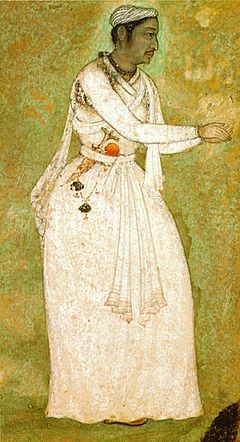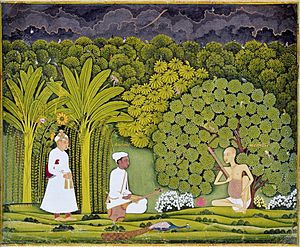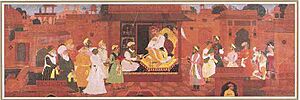Tansen facts for kids
Quick facts for kids
Tansen
|
|
|---|---|

Portrait of Mian Tansen painted around 1585-1590
|
|
| Background information | |
| Birth name | Ramtanu Pandey |
| Born | c. 1493 or 1500 Gwalior, Tomar Kingdom (modern day Madhya Pradesh, India) |
| Died | 26 April 1589 (aged 89-96) Delhi, Mughal Empire (modern day Delhi, India) |
| Genres | Hindustani Classical Music |
| Occupation(s) | musician, instrumentalist, vocalist, music studies |
| Years active | Till 1562: Raja Ramchandra Singh, Rewah After 1562: Emperor Akbar |
| Associated acts | Swami Haridas |
Tansen (born around 1493 or 1500 – died April 26, 1589) was a very famous Hindustani classical musician. People often called him Sangeet Samrat, which means "Monarch of Music." He was born into a Hindu family and learned his amazing musical skills in the area that is now Madhya Pradesh, India.
Tansen started his career and spent most of his adult life working for the Hindu king of Rewa, Raja Ramchandra Singh. His musical talent became widely known. This fame caught the attention of the powerful Mughal Emperor Akbar. Akbar asked Tansen to join his group of musicians.
Tansen didn't want to leave at first, but Raja Ramchandra Singh encouraged him to share his music with more people. So, in 1562, when Tansen was about 60 years old, he joined Akbar's court. His performances were so special that many court historians wrote about them. Akbar thought Tansen was one of his Navaratnas, meaning "nine jewels" or most important people. He also gave Tansen the special title "Mian," which means a learned or respected person.
Tansen was a composer, a musician, and a singer. Many musical pieces in northern India are said to be his work. He also played and made musical instruments better. He is one of the most important people in the North Indian style of Indian classical music, called Hindustani. His music studies and compositions from the 1500s inspired many. Many gharana (regional music schools) in North India see him as their founder.
Tansen is remembered for his amazing Dhrupad compositions. He also created several new ragas (musical scales or melodies). He wrote two classic books about music called Sri Ganesh Stotra and Sangita Sara.
Contents
Tansen's Early Life
The exact date and place of Tansen's birth are not fully clear. Most sources say he was born around 1500 CE, or sometime between 1493 and 1506. His life story also has many different accounts, with some common parts. It's hard to separate the real facts from the many legends about him.
According to most stories, Tansen's childhood name was Ramtanu. His father, Mukund Pandey, was a rich poet and a skilled musician. For a while, his father was also a Hindu temple priest in Varanasi.
Tansen learned and perfected his musical art in the area around Gwalior, in modern Madhya Pradesh. He started his career and spent most of his adult life working for the Hindu king of Rewa, Raja Ramchandra Singh. Tansen's musical skills and studies became very famous there. He was a close friend of Raja Ramchandra Singh, and they often made music together.
Tansen's fame reached the Mughal Emperor Akbar. Akbar sent messages to Raja Ramchandra Singh, asking Tansen to join his court musicians. Tansen first said no, wanting to live a quiet life. But Raja Ramchandra Singh encouraged him to share his music with more people. So, he sent Tansen, along with gifts, to Akbar. In 1562, when he was about sixty years old, Tansen arrived at Akbar's court for the first time.
Tansen's influence was very important in shaping the Hindustani classical music we know today. Many musicians and schools of music trace their origins back to him. For these gharanas (schools), Tansen is seen as the founder of Hindustani classical music.
Learning Music

The stories about Tansen's early life and schooling are different depending on whether they come from Hindu or Muslim legends. In Hindu stories, the Hindu saint and musician Swami Haridas was a major influence on Tansen. In Islamic stories, a Sufi Muslim mystic named Muhammad Ghaus is said to have influenced Tansen. Many experts agree that Swami Haridas was Tansen's main teacher. It's also clear that Tansen knew Muhammad Ghaus. However, it seems Tansen was more focused on music itself than on one specific religion.
Tansen showed musical talent when he was just 6 years old. At some point, he became a student of Swami Haridas. Haridas was a famous composer from Vrindavan and part of the court of Raja Man Singh Tomar in Gwalior. Haridas was known for the Dhrupad style of singing. Tansen's talent was recognized early, and the ruler of Gwalior gave him the special title 'Tansen'. Haridas was considered a legendary teacher. People said that only his teacher was as good as Tansen.
From Haridas, Tansen learned to love Dhrupad music. He also became interested in composing songs in local languages. This was a time when the Bhakti tradition was changing music from Sanskrit to local languages like Brajbhasa and Hindi. Tansen's compositions also show this trend. Later, Tansen's father passed away, and he returned home. It is said he used to sing at a local Shiva temple.
Some stories say Tansen met the Sufi mystic Muhammad Ghaus. This meeting brought Sufi influences into Tansen's life. Even later in his life, he continued to compose songs in Brajbhasha. These songs often featured traditional Hindu themes like Krishna and Shiva.
Having musicians like Tansen in Akbar's court helped bring together Hindu and Muslim traditions within the Mughal Empire. Tansen became one of the treasured Navaratnas (nine jewels) of Akbar's court. There, he received the special title Mian, and became known as Mian Tansen.
Tansen's Compositions
Tansen's musical compositions covered many topics. He used the Dhrupad style of music. Most of his songs came from Hindu Puranas (ancient texts). They were composed in Braj Bhasha and praised gods and goddesses like Ganesha, Saraswati, Surya, Shiva, and Vishnu (including Narayana and Krishna). He also composed and performed songs praising kings and Emperor Akbar.

Tansen's Family
Tansen married a woman named Hussaini. They had four sons and one daughter: Surat Sen, Sarat Sen, Tarang Khan, Bilwas Khan, and Saraswati. All five of his children became skilled musicians themselves. His daughter Saraswati also married Misra Singh, who was a famous veena-player. One legend says that Tansen was also married to a daughter of Akbar named Mehrunissa.
Tansen's Death
The exact year Tansen died, like much of his life story, is not completely clear. Some Islamic historians say Tansen died in 1586 in Delhi. They say Akbar and many people from his court attended the funeral, which followed Muslim customs. Other stories, written by Hindu historians and in the Akbarnama (a book about Akbar), say he died on April 26, 1589. These accounts say his funeral mostly followed Hindu customs.
Tansen's remains were buried in the tomb complex of his Sufi master Shaikh Muhammad Ghaus in Gwalior. Every year in December, a festival called the Tansen Samaroh is held in Gwalior to celebrate Tansen's life and music.
Tansen in Popular Culture
Several Hindi films have been made about Tansen's life. These movies often tell stories that mix facts with legends. Some of these films include Tansen (1943), which was a musical hit. Other films are Tansen (1958) and Sangeet Samrat Tansen (1962). Tansen is also an important character, though often in the background, in the musical film Baiju Bawra (1952). This movie is based on the life of another musician from Tansen's time.
Tansen's Legacy
Tansen Award and Festival
A national music festival called 'Tansen Samaroh' is held every year in December. It takes place near Tansen's tomb in Behat to honor his memory. The Tansen Samman or Tansen award is given to great performers of Hindustani Classical music.
Buildings Connected to Tansen
The fort at Fatehpur Sikri is strongly linked to Tansen's time in Akbar's court. Near the emperor's rooms, there was a pond built on a small island. Musical performances were held there. Today, this pond, called Anup Talao, can still be seen near the public audience hall Diwan-i-Aam. It has a central platform that can be reached by four small bridges. It is said that Tansen would perform different ragas (melodies) at different times of the day. The emperor and his special guests would reward him with coins. Tansen's supposed home is also nearby.
Miracles and Legends About Tansen
Many stories about Tansen, found in Akbar's court records and music school writings, are inconsistent and describe amazing miracles. Among the legends about Tansen are stories that he could bring rain by performing Raga Megh Malhar. Another legend says he could light lamps by performing Raga Deepak. Raga Megh Malhar is still played today. However, Raga Deepak is no longer known, though three different versions exist. It's not clear which, if any, is the same as the Raga Deepak from Tansen's time.
Other legends say he could make wild animals listen carefully to his music, or even talk their language. Once, a wild white elephant was caught, but it was very fierce and couldn't be tamed. Finally, Tansen sang to the elephant, and it calmed down. The emperor was then able to ride it.
Crater Named After Tansen
A crater on the planet Mercury has been named in Tansen's honor.
-
Fatehpur Sikri audience chambers, with Anup Talao on the left.
See also
 In Spanish: Tansen (músico) para niños
In Spanish: Tansen (músico) para niños








